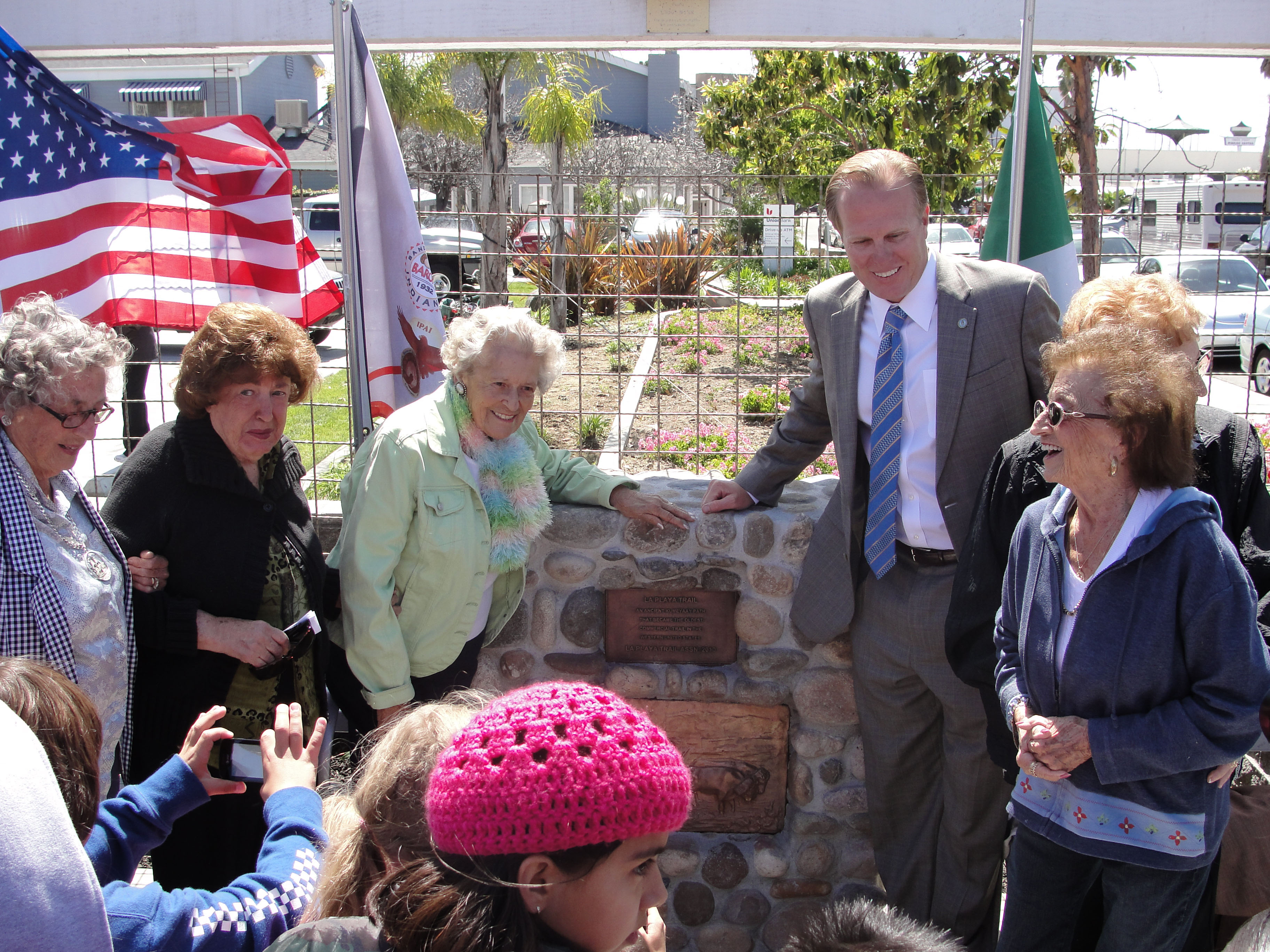
By Donald H. Harrison

SAN DIEGO—The intersection which Jewish settler Louis Rose called 1st and Main Streets back in 1869 as of Thursday, April 29, bears a plaque recognizing it as the place where the community of Roseville began. Today Roseville is a section of Point Loma, a neighborhood in the City of San Diego.
The plaque at what is today the renamed northeast corner of Rosecrans Street and Avenida de Portugal by the Union Bank building was unveiled by San Diego City Councilmember Kevin Faulconer, whose 2nd Councilmanic District includes the 30-block-long, 8-block-wide Roseville community. He was accompanied by five octogenarian alumni of Cabrillo Elementary School who, back in their student days in 1934, participated in a similar ceremony. They included Edwinna Goddard, Bernice Hollerbach, Mary Correia Martin, Angie Vierra Mauricio and Rita Bellatori. County Supervisor Greg Cox participated in the speech making.
Both the 1934 ceremony and this one 76 years later included the dedication of a time capsule to teach future generations. The problem was that following widening of Rosecrans Street decades ago, the location of the time capsule became a mystery. So to make up for it, members of the La Playa Trail Association decided to include in the current time capsule materials of relevance then and now.
For example, there was a copy of a press release and photo from the 1934 dedication and an invitation to the 2010 event. There were books about the Kumeyaay Indians who have lived in San Diego since before the times of recorded history, about Point Loma’s history since Portuguese explorer Juan Rodriguez Cabrillo waded ashore in 1542 and claimed the area for Spain, and various articles, photographs and historical pamphlets about Point Loma’s rich history.
“History is rich along La Playa Trail,” commented Patti Adams, past chair of La Playa Trails Association, emceeing the event. Markers including the one dedicated on Thursday are engraved with the image of a carreta—a Spanish ox cart—and an Indian, the latter acknowledging that “the Kumeyaay people, who lived here long before anyone else sailed into the bay, used it as their path to the beach,” according to Adams. This one also bore the legend: “La Playa Trail–An ancient Kumeyaay path that became the oldest commercial trail in the Western United States… La Playa Trail Assn. 2010.”
As author of Louis Rose: San Diego’s First Jewish Settler and Entrepreneur, I had the opportunity to tell the assemblage that Rose had grown up in Neuhaus-an-der-Oste, a river near Germany’s Elbe River, on which there was a continuous volume of commercial shipping. When Rose immigrated to the United States, he settled first in New Orleans, along the banks of the Mississippi River, another important commercial river.
When he arrived in San Diego in 1850, he wondered why the city was located below Presidio Hill instead of the banks of San Diego Bay. The answer was that Spaniards had chosen Presidio Hill because it could be defended, was near the freshwater San Diego River, and had two Kumeyaay settlements nearby with residents who could potentially be converted to Christianity. When Mexico became independent of Spain, the soldiers who lived in the Presidio moved down the hill to the area that we today call Old Town and that’s where San Diego sprung up.
Rose and his wagon train friend James Robinson assembled land along the bay, Robinson dying before they could complete their plans to build the town. When at last Rose laid it out four years following the end of the Civil War, another town – Horton’s Addition—was being built along another portion of the bay. Alonzo Horton proved himself to be the more astute and energetic developer. Today his area is downtown, and Rose’s area is one of the nicest residential and boating neighborhoods of San Diego.
With the five participants of the 1934 ceremony leading –and schoolchildren from three current classrooms at Cabrillo Elementary School following—the three stanzas of the Cabrillo School Song then were sung:
“My name is Juan Cabrillo/and I sail the seven seas/ My ship is strong and beautiful’/ I sail whenever I please/ Of all the shores that I did see/ on San Diego Bay/ Point Loma points the way,” it begins somewhat historically.
“Hail to Cabrillo!/ The school we love the best./ Rah! Rah Cabrillo—the finest in the west/ Oh, we work so hard and play so hard/ To win the games for all/ The other schools do very well/ But we’re the best of all.
“We work so hard and play so hard/ To win the games for all/ The other schools do very well/ But we’re the best of all!”
County Supervisor Cox, indicating the five members from the 1934 ceremony, said that their presence “tells me what Point Loma is all about: family, history, and continuity… I am very proud to be here as part of this historic event today…”
Noting that the new monument will have a time capsule, he predicted unlike its predecessor, “this one looks pretty substantial: I don’t think anyone will lose the time capsule in this monument.”
City Councilmember Faulconer revealed that in 1934, Point Lomas charged 10 cents per person to attend the ceremony dedicating the old marker, so as to pay for it. “I’m glad to see that today it is already paid,” he said.
Another of six markers along La Playa Trail had been dedicated in 2006, but whereas this one is on a sidewalk, the one in the Midway Section of town (near the Sports Arena) was along a center strip on a busy highway. “We were dodging cars,” Faulconer recalled. This monument, a safe distance from the road, likely will attract “Point Lomans and City of San Diego residents alike who care about their history.”
Adams said that one of the next projects expected to be completed will be historic murals on the side of Gus’s Subs and Pizza at 1166 Rosecrans Street near Byron Street.
*
Harrison is editor of San Diego Jewish World